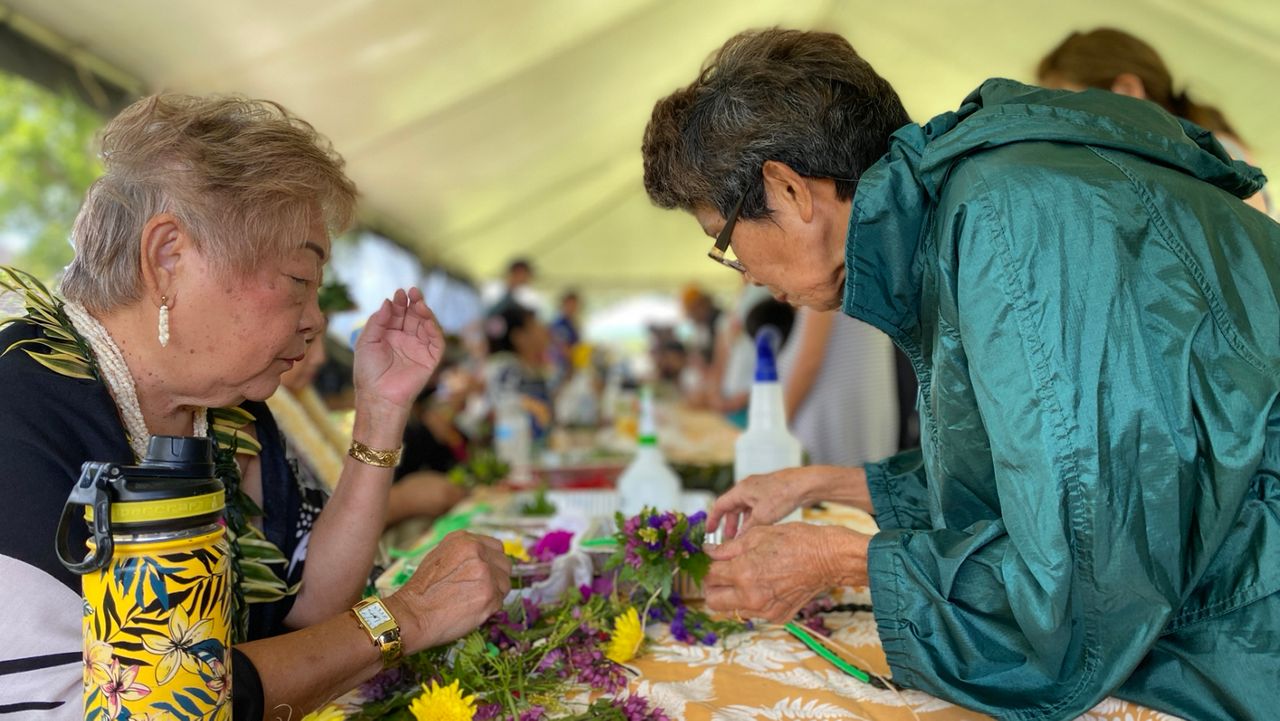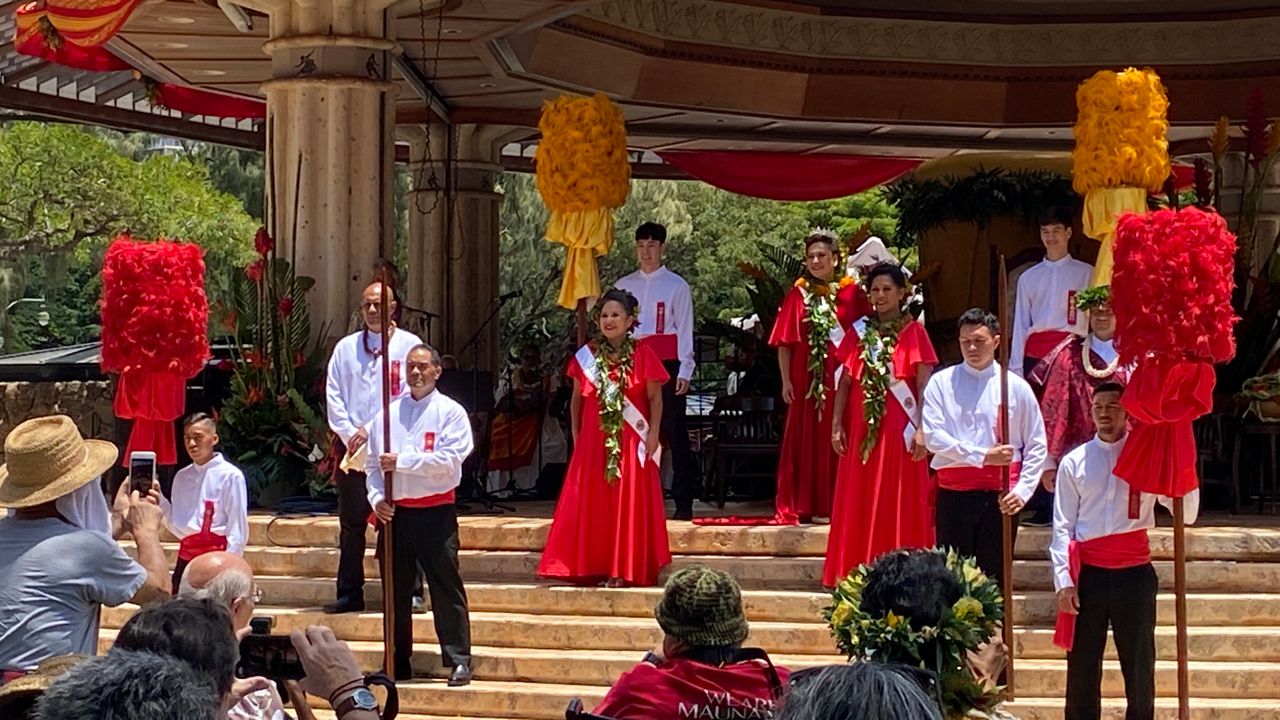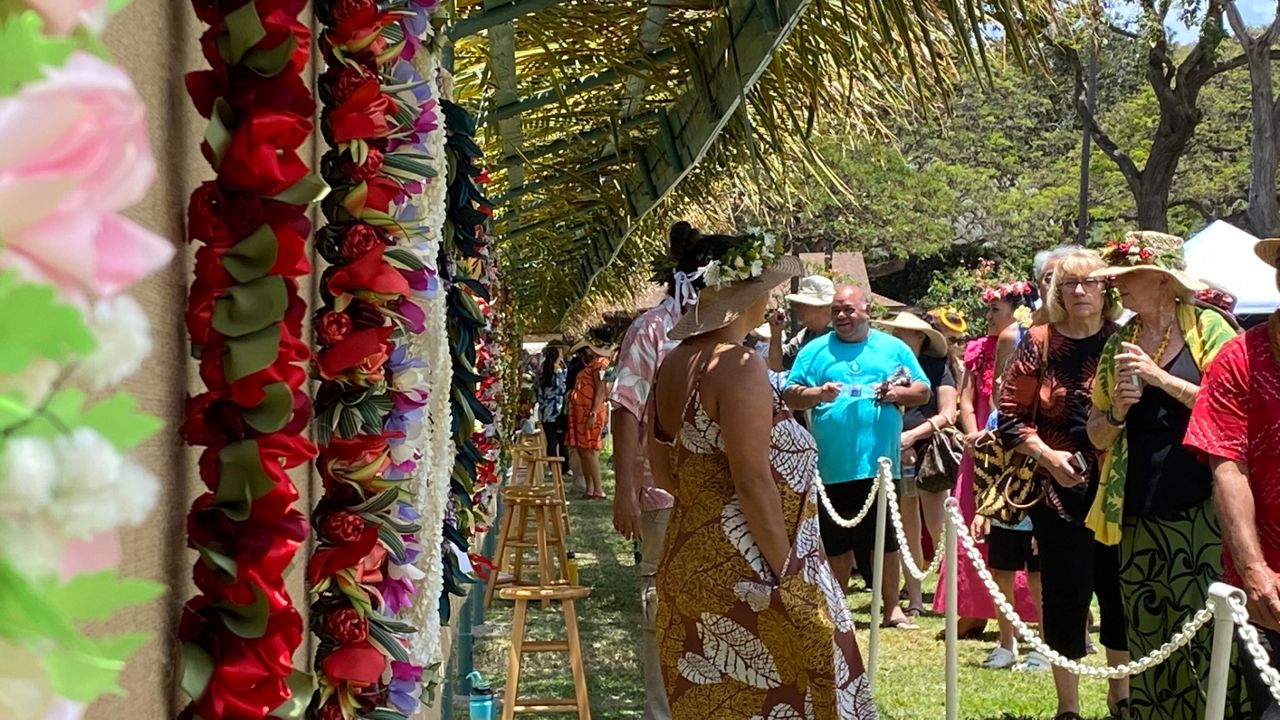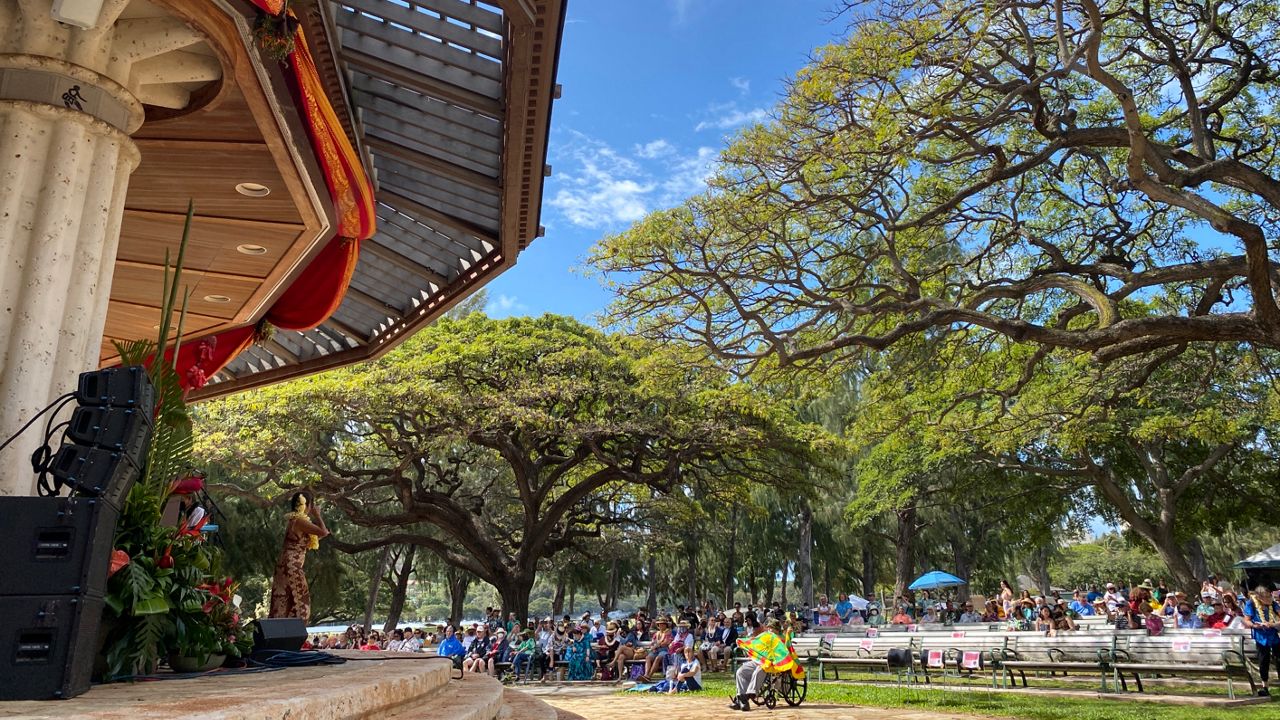HONOLULU — There’s a hum in the air around Queen Kapiolani Park. After a two-year hiatus, the annual Lei Day Festival, now in its 94th year, is back.
Lei, craft, retail and food vendors are setting up their booths, preparing to welcome back the crowds. Staff from the City and County of Honolulu’s Department of Parks and Recreation have arrived early to set up chairs, signs, decorate the bandstand, and ensure the grounds are free of debris. Local residents have also set up their chairs and picnic area to enjoy the events of the day. Colorful lei adorn shoulders, haku are placed just so on the head or hat.
Kaiulani Kauahi planned and coordinated the Lei Day Festival from 2005 until the end of September 2021. She began at DPR as the culture and arts coordinator, training staff in the area of culture and arts, Hawaiiana, various kinds of arts and crafts, music and dance and creative drama.
There were only about two to three people in each section, so when city-wide events were held, every section had to help out. “Overall coordination of Lei day, just recreation alone, (there were) maybe 150 (people),” said Kauahi. “That doesn’t include maintenance. We also had volunteers who would come.”
Kauahi started with DPR at a time when interest in Lei Day was waning. She’s the first to say that obtaining grants helped her to grow the program. She was able to hire “name” entertainment and actively promote the event. Retiring after 16 years, she misses it.
“It’s a year-long of planning. And it’s not easy. A lot of variables change along the way,” Kauahi shared. “But my love of Lei Day … it became a calling. My understanding and the importance of lei became more and more … it was really centered around aloha, the aloha spirit.”“It’s a year-long of planning. And it’s not easy. A lot of variables change along the way,” Kauahi shared. “But my love of Lei Day … it became a calling. My understanding and the importance of lei became more and more … it was really centered around aloha, the aloha spirit.”
Kauahi refers to Auntie Pilahi Paki, “a beloved Native Hawaiian poet, philosopher, linguist, educator, spiritual guide, songwriter, author, and one of the holders of Hawaii’s secrets,” according to hoikaha.org. Auntie Pilahi shared the meaning of Aloha in 1970 at the Governor’s Conference on the Year 2000, at which panelists from across the state that included scholars and intellectuals were discussing the meaning of Aloha, and could not come to an agreement.
“Everything around lei really is centered around this,” said Kauahi. “Because when you’re making lei you cannot be in one bad mood. Part of your mana, your spirit, when you’re making a lei … you know if you’re in a bad mood, now when I go and give it to you, I pass that over to you. Yeah? This whole thing about the true meaning of aloha, it really is centered around lei.”
Through the event, Kauahi has connected with many and still stays in touch with them — lei makers, volunteers, each generation of the Lei Court, kamaaina and visitors who have remarked on the kindness of staff and love the one-on-one interaction at Kulana Lei, where lei artisans offer demonstrations all day long.
One of the returning volunteers is Miki, originally from Japan, who is now a local resident. “She adopted us,” said Gina Loveland with a smile. Loveland assisted Kauahi when she was with DPR as a recreational aide. “Miki acts as our interpreter now.”
“We really do become a family to one another,” said Kaiulani. “There’s one woman from Arizona; her name is Sandy. She lets us know when she’s gonna be here. All these are people we’ve brought into our Lei Day family. They come year after year after year. Those that come from the Mainland or Japan, they actually schedule their vacation during this time.
“For me, it’s these connections. Lei helps people make connections.”

Lei Day was first celebrated on May 1, 1928, when a few people wore lei around Downtown Honolulu. More people began wearing lei on May 1 as the years passed, and so began the “May Day is Lei Day in Hawaii” tradition. The first Lei Queen, Miss Nina Bowman, was crowned by Honolulu Mayor Charles Arnold in 1928.
In 2008, the City and County of Honolulu set out to establish the world’s longest lei. But there was a moment of panic as it was short. With not much time to spare before the noon deadline, the KCCN DJs on stage called out to the audience for help. Folks in the audience ran to the stage as they took off lei from around their necks, people went to buy lei from the vendors, some vendors even gave their lei. They made the deadline measuring just over a mile at 5,336 feet in length.
The pandemic brought on another obstacle when large, in-person events were restricted. “During the COVID-19 pandemic, the island community found innovative ways to celebrate this uniquely Hawaiian holiday,” said Nathan Serota, a spokesperson for DPR. “This included a video presentation to mark Lei Day in 2021, and the Na Lei Koa in 2020 to honor our first responders.”
He adds, “We are thrilled to bring the event back to Kapiolani Park as we celebrate all things lei, the universal symbol of aloha. It has been an absolute privilege to help organize this event. We have such talented and creative DPR employees who dedicate themselves to making this event a pillar of Hawaiian cultural events on Oahu and around the world.”

The opening of the 94th Lei Day Festival began with an oli (chant) to start the day on the right note, and was followed by a jubilant performance by the Royal Hawaiian Band accompanied by vocalists and hula. A hula halau (group) performed, then Honolulu Mayor Rick Blangiardi shared a few words, energetically welcoming everyone back to an event that he said epitomizes the aloha spirit.
Following the Lei Court Investiture and offering of hookupu (a tribute) to the court by family and friends, emcee Kimo Kahoano invited past lei queens and princesses to perform a hula. It was all in the moment. Afterwards, he said, “This was spontaneous. It’s not a Hawaiian word. It’s beautiful, isn’t it?” The audience agreed.
Sounds of the steel guitar floated in the air from the Hawaiian Steel Guitar Association tent where an audience had gathered to hear local long-time steel guitarists, who quizzed the audience, asking if they knew that the steel guitar originated in Hawaii.
Across the way at Kulana Lei, a row of aunties were busy guiding individuals with lei demonstrations.
Speaking about the lei makers, many of whom have invested much time and effort into Lei Day, Kauahi said, “So many of them will share with people because they want to see the art continued. Getting our youth involved and people who just show a lot of interest, they’re very supportive of them.”
By this time, the Lei Court have made their way to the Lei Contest Exhibit, signaling its opening to the public, who have been waiting in line to view the beautifully handcrafted lei up close. The Lei Queen and Court make their way along the display, followed by guests, then it’s finally the public’s turn.
Behind each lei is a story of the lei maker and the care they took to make their work of art.

“These lei makers are talented,” said Kauahi. “So many of them grow their own gardens. If they’re lucky to have a big yard, they’ll have a lei garden and a food garden. Some of them will even have a second refrigerator to store their lei materials because it shouldn’t be stored as cold as our food. They also learned how to grow native Hawaiian plants and other types of plants. Home cultivation can be a little tricky sometime, so they took their time, they learned and they shared their skills. It’s not like, ‘Oh, I not going tell you.’ They are willing to teach.”
“It’s almost their mission to teach because they’re getting older,” adds Loveland.
A reminder of Native Hawaiian practices is the respect given to the natural world and how everything is connected. Kauahi said that with lei etiquette and protocol, the lei is never simply thrown away once its color and fragrance are gone.
“You take the flowers and you put them in your yard so that they can return to the earth and help the next generation of flowers and plants growing,” explained Kauahi. If there is a string, “you should remove the string and throw it away. If it’s natural materials, then really, you can just put it in the yard or take it out to the ocean.
“When we get a lei, we need to be a little better about what we do with that lei afterwards. It took someone time and energy to go out and gather that material, to clean it, and to fashion it into a lei. And now you’re gonna throw it away? Put it in the trash? You wouldn’t normally do that to a gift from someone, so our lei needs to be treated with respect and love. And you think about the land that we live in now. We need to take care of this place that we’re living in. We really do need to be very mindful.”
After the Lei Day Festival, the public is invited on May 2 to join the staff and guests at 9 a.m. at Mauna Ala, the Royal Mausoleum, in Nuuanu, where the remains of alii are interred.
“These lei are beautiful, stunning, and so it’s our way of returning that love and mana (spirit) to honor our alii (chiefs, monarchy) at Mauna Ala,” explained Kauahi. “Many of our alii really worked on doing their best to maintain the Hawaiian language and the various culture and arts, so it’s important for us to mahalo them back for these treasures that we know about now and are continuing. So it’s very, very special.”
She explains that for the public, it’s now their opportunity to actually touch the lei.
On Lei Day, the lei are hung on a display wall about four feet from the public filing past them. Staff are on hand to explain the lei if needed, and can even turn the lei around if someone is interested in seeing the back of the lei, but there is no touching.
“At Mauna Ala, you’ll get to pick up the lei and take a look at the construction and get a better look at the materials that made the lei, because when you look at it, it is like a tapestry. You may not realize all the different materials in the lei from a distance, but up close, “Now I see palapalai, oh, I see pupia … you can see all those things.
“At Mauna Ala, Kamehameha is there, Kalakaua is there … Lunalilo was the first king voted in by the people, so when he passed away, he wanted his body to be in the people’s cemetery, and at the time, it was Kawaiahao Church. So after Mauna Ala, we will go down to Kawaiahao and do a short ceremony at Lunalilo’s (grave), and take lei over there as well.”
Reflecting about her 16 years with Lei Day as her kuleana, her responsibility, Kauahi says there’s a relationship between the person with the responsibility and what they are responsible for. There is also a privilege or honor that comes along with that responsibility, therefore, it’s not taken lightly.
“I felt my kuleana to Lei Day was to honor all those who began and contributed to past Lei Days by keeping the momentum moving forward,” she shared, “and to provide an ongoing legacy for its nearly 100-year anniversary and well into the future.”
CORRECTION: A previous version of this story incorrectly identified the responsibilities of Kaiulani Kauahi. Lei Day was first celebrated May 1, 1928, not 1927, as was originally noted on the festival's website. (May 2, 2022)
Sarah Yamanaka covers events, tourism and community news for Spectrum News Hawaii.




